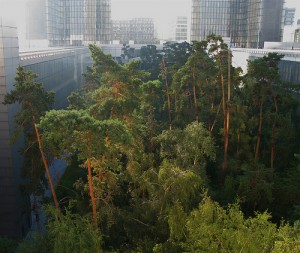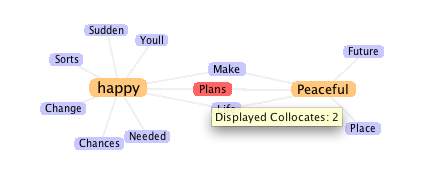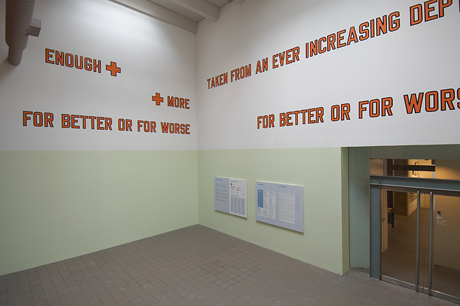Joyce pointed me to a National Film Board (NFB) interactive work, Out My Window: Interactive Views from the Global Highrise. The work, directed by Katerina Cizek documents the lives of people in apartments through their apartments. For each apartment there is a 360 degree view that you can pan around (sort of like QuickTime VR.) Certain things can be clicked on to hear and see short documentaries with the voice of the dweller. These delicate stories are very effective at giving us a view of apartment life around the world.
Category: Digital and Interactive Art
MA in Experimental Digital Media at Waterloo
Thanks to David I found out about the University of Waterloo’s new MA in Experimental Digital Media. The MA looks like something you could do in 12 months, but it isn’t clear. The MA doesn’t have a thesis – instead it has project which can be a prototype with commentary:
The Project is the culminating point of the program, in which students demonstrate a mastery of critical theories and theoretical concepts by embodying them in digital artifacts, environments, or practice. Projects will entail the design, conception or production of objects-to-think-with, evocative objects that focus attention on key cultural and theoretical issues in the humanities.
In many cases the project will remain at a design or prototype stage, although the manufacture of the object is by no means ruled out in principle. The design or prototype itself will be accompanied by a commentary of 40 pages in which the student will describe the theoretical and cultural context of the project and its aims, analyse its feasibility and its functioning, describe its cultural and rhetorical significance, and indicate its possible lines of development.
Bibliothèque Nationale – a set on Flickr

A couple of weeks ago I went to Paris for a meeting and was able to visit the new (see my Flickr set on the Bibliothèque Nationale). It is hard to tell from one short visit how it is as a library, but it is a stunning building to walk around. It spoke to me of exclusion – a cave (or inferno) of knowledge that you get progressive access to. The deepest levels are reserved for the true scholars (not tourists like me.)
Drawger.com

Shannon sent me a link to the The Museum of Forgotten Art Supplies at Drawger.com. Many of the items are more design or publishing supplies. Many of them are evocative of “the good old days” when we used analogue tools.
The Power Plant: Laurence Weiner
The Globe and Mail has a review of the Lawrence Weiner show at the The Power Plant in Toronto (who must have one of the worst gallery web sites I’ve seen in a long time – lots of navigation for no content in very small type!) e-flux has a better site about the show.
The Globe and Mail article, “Brilliantly maddening word sculptures” by Gary Michael Dault (Thursday, March 19th, 2009, Section R, p. 1) nicely explores the issues around language and art raised by such conceptual work. Dault walked through the show with Weiner and Dault ends the articles with,
We talk about whether language actually means anything at all. “Language does mean something,†Weiner contends gaily, “but not what you thought it meant.†There’s the other side of a cul-de-sac for you.
Weiner’s sculpture with words goes back to the 1960s. His Declaration of Intent (1968) articulates a relationship between instructions for a work of art and the fabricated work.
“1. The artist may construct the piece. 2. The piece may be fabricated. 3. The piece need not be built. Each being equal and consistent with the intent of the artist the decision as to condition rests with the receiver upon the occasion of receivership.”
Does it matter if the work is actually put together from bits and pieces? Do the bits and pieces of social media (like the bits of blog entires, or the pictures of words in the Dictionary) make a whole or its semblance?
Neave Imagination …big wobbly elephants
Neave Imagination (…big wobbly elephants) is a lovely Flash toy that works great on a large screen.
Play with the big wobbly lines and you’ll soon have an active imagination.
Try his other toys – many are beautiful and they work on a 30″ screen.
The Pool
 The Pool is a project from the University of Maine new media group, Still Water who also developed ThoughtMesh. It is a collaboration between faculty and students that provides a visual space where ideas can be described (intent), approached and released. (The metaphor is fishing and releasing.) It encourages sharing, rating, and redevelopment of ideas. The have pools for code and art.
The Pool is a project from the University of Maine new media group, Still Water who also developed ThoughtMesh. It is a collaboration between faculty and students that provides a visual space where ideas can be described (intent), approached and released. (The metaphor is fishing and releasing.) It encourages sharing, rating, and redevelopment of ideas. The have pools for code and art.
The Pool offers a very different message. This online environment is an experiment in sharing art, text, and code–not just sharing digital files themselves, but sharing the process of making them. In place of the single-artist, single-artwork paradigm favored by the overwhelming majority of studio art programs and collection management systems, The Pool stimulates and documents collaboration in a variety of forms, including multi-author, asynchronous, and cross-medium projects. (learn more -> purpose)
The Chronicle of Higher Education in New-Media Scholars’ Place in ‘the Pool’ Could Lead to Tenure (Andrea L. Foster, May 30, 2008, Volume 54, Issue 38, Page A10) discusses The Pool as an alternative form of peer review for getting tenure, which rather misses the point for me. What impresses me about this is the collaboration between students and faculty in experimentation around structured collaboration. The Pool could dry up, and some of the code pools seem rather poorly stocked, but that wouldn’t detract from what seems like thoughtful and sustained experimentation with social collaboration. The wiki, Flickr, Facebook and blog models of Web 2.0 social knowledge dominate our thinking about what is possible. The Pool reminds me that we don’t have to adapt successful models, there is room for new ideas. Catch this and release it.
Fortune of the Day – Fortune Hunting

Lisa Young with the support of the Brown University Scholarly Technology Group (STG) has developed a Fortune of the Day – Fortune Hunting interactive art site based on a collection of scanned fortune cookie slips she created. It has elements of a public textuality site like the Dictionary though focused completely on fortunes. The interface is simple and elegant. I believe it has been exhibited recently for the first time. The project uses the TAPoRware Visual Collocator for one of its interfaces.
Dictionary of Words in the Wild: Over 3000

The Dictionary of Words in the Wild now has over 3000 images and almost 4000 unique words.
I’ve just finished 4 days hiking in the wilds of the northern shore of Lake Superior (Pukaskwa National Park) on one of the most spectacular back country hiking trails I know of. What struck me in the woods an on the shores of Superior was that there are no words in the wild unless scratched on a tree or rock. The only words I saw were all the logos on our clothing, tent, sleeping bags and so on. It really isn’t wild if there are words.
Krazy: Vancouver Art Gallery
While in Vancouver for the Congress, I went to the Vancouver Art Gallery to see the show Krazy! The Delirious World Of Anime + Comics + Video Games + Art which brought together in one exhibit significant works from Anime, Comics, Graphic Novels, Manga, Video Games, Animation and Art. The show was better than I had expected reading the article in the Globe and Mail. For each section they got curators with a background in the field. For example, Will Wright (of SIMs fame) did the video game section.
The challenge of such an exhibit is how to show stuff like comics that are meant to be consumed in another form. The video game section was particularly problematic – they had inkjet printouts of Spore (upcoming game by Wright) screens and characters (that weren’t much better than a good screen), but it wasn’t like the comic section where they had original art and sketches. To exhibit in an art gallery the types of work that are consumed in other contexts was more an exercise in legitimation – telling us these should be thought of as art. The selection of what was important was what was really being exhibited – a “best of” list of lists with commentary on the walls.



